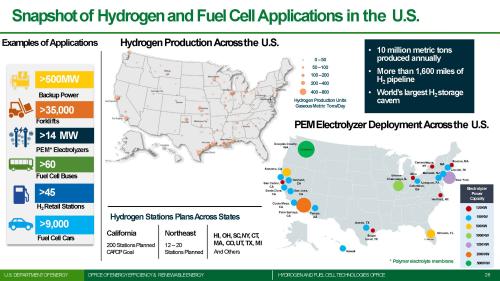On January 12th, 2021, the UT Energy Institute and Cockrell School of Engineering hosted the Texas Hydrogen Roundtable. The event brought together international thought leaders from industry, government, and academia to discuss near-term challenges and opportunities across the hydrogen value-chain. The expert discussants, totaling more than 20 leaders, took deep dives into hydrogen production, storage and distribution, transportation, and industrial applications, identifying first movers as well as critical gaps where private investment and adaptation to public policy are needed.
The Roundtable identified points of consensus across distinct groups and raised new questions about the timeliness of opportunities for Texas’s hydrogen economy ambitions.
Hydrogen Production. 10 million metric tons of H2 already produced annually, but mainlining requires achieving clarity on expectations for low-carbon blue and green hydrogen
- Near and medium-term blue hydrogen cost advantages present an opportunity for accelerating scale-up as a bridge fuel as hydrogen market share increases overall
- Non-harmonized policy prescriptions and policy goals are a tension threatening near-term market potential of low-carbon hydrogen production
- DOE is launching H2NEW, an electrolyzer consortium, with a goal of reducing production costs to below $2/kg for green hydrogen
Hydrogen Storage and Distribution. High-capacity hydrogen storage, which has one-third the energy capacity of natural gas, is an infrastructure limitation that must be addressed
- Electrolyzer hydrogen production from renewables is making headway
- Mitsubishi partnered with Intermountain Power Plant in Utah for a demonstration project
- Similarities to liquefied natural gas have accelerated pace of hydrogen storage and transmission demonstration
- Geological storage methods, the most common current approach for natural gas, likely go-to technique for large-volume hydrogen storage
- Liquefied hydrogen supply chain expected to resemble evolution of the LNG supply chain in recent years
Hydrogen Applications in Transportation. Pairing deployment of FCEVs with ramp up of hydrogen production and transmission infrastructure is an opportunity to derive economic and decarbonization synergies.
- Blue hydrogen presents an opportunity for Texas to carbon intensity in transportation while driving down hydrogen technology costs
- Leveraging extended driving range and short refueling times, coupling FCEVs deployment in Texas’s trucking sector with emergent hydrogen industry is a first-mover opportunity
- The DOE’s Million Mile Fuel Cell Truck Consortium kicking off to emphasize fuel cell durability, performance, and cost
Industrial Applications and Opportunities. Hydrogen is one of a few pathways with market ready opportunities to decarbonize heavy industry, in which some processes like ammonia production already use hydrogen
- A staged approach for transitioning to a zero-carbon hydrogen industry begins with installing fit-for-purpose hydrogen technologies and integrating blue hydrogen; graduating to green hydrogen as costs fall
- 24-hour operating schedule common in heavy industry requires a constant, reliable power supply, which limits uptake of renewables but not hydrogen
- With ongoing learning benefits and cost reductions, hydrogen could substitute for natural gas in high temperature industrial heat applications
Texas Hydrogen Roundtable: Benefiting from an Emerging Technology
View the full program video playlist and download the slides
Welcome and Objectives
Christine Dixon Thiesing, Office of the Vice President for Research, UT Austin
Bob Hebner, Center for Electromechanics, UT Austin
Varun Rai, Energy Institute, UT Austin
Energy in Texas: Policymakers’ View
Remarks by The Honorable Michael McCaul, U.S. House of Representatives
Co-Chair, Congressional High Tech Caucus
Remarks by The Honorable Drew Darby, Texas House of Representatives
Vice Chair of the House Business & Industry Committee and Member, House Energy Resources Committee
Underlying Context for Hydrogen: Global and U.S. Perspective
Bob Hebner, Center for Electromechanics, UT Austin
Sunita Satyapal, U.S. Department of Energy
Daryl Wilson, Hydrogen Council
H2@Scale Project and Other Hydrogen Research at UT Austin
Nico Bouwkamp, Frontier Energy
Varun Rai, Energy Institute, UT Austin
Hydrogen Production: Pathways and Critical Needs
Al Burgunder, Linde
Joe Powell, Shell
Nakul Prasad, Siemens
Brian Weeks, Gas Technology Institute
Remarks by The Honorable Marc Veasey, U.S. House of Representatives
Member, House Committee on Energy and Commerce
Hydrogen Storage and Distribution: Infrastructure Development and Coordination
Bob Oesterreich, Chart Industries
Gordon Salahor, Wolf Midstream
Mark Shuster, Bureau of Economic Geology, UT Austin
Hydrogen Applications in Transportation and Power Generation
Matthew McCluskey, EDF Renewables
Ricky Sakai, Mitsubishi
Ed Young, Toyota
Industrial Applications and Opportunities for Hydrogen
Tristan Aspray, ExxonMobil
Jack Broodo, Dow
Brett Perlman, Center for Houston’s Future


